Cucumbers grow well and bear fruit on the windowsills. The tradition of growing this crop in the house has developed for a long time. During this time, it was possible to select the most suitable varieties and hybrids. A system for caring for a cucumber growing on a windowsill has also been worked out.
Varieties and hybrids
Many people remember the famous amateur variety "Room Rytov". For a long time it was considered almost the only variety that can be grown in the house. Gradually, not only the number of amateurs growing cucumbers on window sills increased, but also the number of varieties and hybrids suitable for this. These are parthenocarpic (self-pollinated) hybrids: "April", "Balalaika", "Karapuz", "Claudia", "Klinsky", "Korolek", "Lada", "Legend", "Manul", "Mashenka", "Moscow greenhouse ”, “Ant”, “Prestige”, “Stella”, “Tournament”, etc. They do not need to be pollinated manually. When choosing a variety, shade-tolerant cucumbers should be preferred.
For growing cucumbers on the windowsill, balcony cucumbers are perfect. These are hybrids "Balagan", "Balcony", "City cucumber", "Calendar", "Hummingbird", "Swallowtail". Balcony-type cucumbers can even be grown in hanging baskets with a volume of at least five liters.
When growing bee-pollinated varieties and hybrids, pollination is carried out manually. Best in the morning. It is convenient to do this with a cotton swab wound around a match, or with a soft brush. With the help of them, pollen is transferred from the male flower (barren flower) to the female (with ovary). You can directly pollinate a female flower with a male one. To do this, the male flower is plucked, all the petals are removed from it, after which the anthers gently touch the stigma of the pistil. To ensure the production of full-fledged fruits, female flowers are pollinated with pollen from male flowers from different varieties.
The soil
Soil mixtures can be purchased at stores or made by yourself. The soil is prepared from equal parts of soddy land (or garden soil), compost, a small amount of coarse sand, wood ash and steamed sawdust. The main thing is the nutritional value and friability of the soil mixture. Of course, the substrate must be disinfected. For example, calcination. Two matchboxes of fertilizers intended for growing cucumbers or other pumpkin crops are added to a bucket of soil mixture. Sometimes, instead of such top dressing, they take nitrophoska. Homogeneous loose soil mixture is poured into five-liter (or more) containers with drainage holes. Many gardeners on the windowsill use plastic buckets, at the bottom of which holes are made to drain water. The earth is moistened the day before sowing seeds.
Sowing seeds
It is difficult to name the most suitable dates for sowing cucumber seeds, which are supposed to be grown in room conditions. They depend on the specific weather conditions that affect the flow of natural light, and on the possibility of installing additional lighting. From November to the end of January, lighting is indispensable. It is better if these are lamps intended for plants. Cucumbers that are grown on window sills can be severely affected by drafts and whiteflies accidentally brought into the house with purchased flowers.
Seeds are sown immediately in a container or in small seedling pots. Seeds are pre-etched in a solution of potassium permanganate and left in a warm, moist environment for germination. The hatched seeds are laid horizontally in holes to a depth of 1.5 cm and covered with moist soil. The planting container, covered with a film or glass, is placed in a warm place (22 - 24 °) and waiting for the emergence of seedlings. As soon as shoots appear, the film (glass) is removed, and the planting container is moved to a cooler (18 ° C) and brightest place.
From germination to fruiting
Place. The place for the cucumber should be bright and spacious. Usually these are window sills, warm glazed loggias, verandas, etc. Foil (mirror film) is often attached next to a growing cucumber or a mirror is placed to increase the illumination by reflected light. Under the landing tank, be sure to put a sheet of foam or a wooden board. This will protect the root system from hypothermia.
Formation. Our task is to form a strong fruit-bearing plant that is easy to care for. The first "surgical" operation is carried out in the phase of 4 - 5 leaves. To do this, pinch the top of the stem. This encourages all lateral lashes to actively grow. They are also pinched over the third - fifth sheet. When growing cucumbers, you will need a suitable support about one meter high. The top of the main stem can later be tied up by hooking the twine to the cornice or attaching it to another suitable object. Lianas are usually pinched over 11 - 12 leaves. When forming, the leaves are protected, the yield depends on their quantity. Mustaches can be removed, preventing the remaining "stumps" from rotting.
Watering. Cucumber is watered (without pouring) with warm water every day or every other day. By any possible means increase the humidity of the air. You can put a flat container filled with water, use a sprayer or humidifier. Sometimes they stretch a transparent film to make an analogue of a greenhouse.
Top dressing. Cucumber needs feeding. These can be ready-made mixtures intended for pumpkin crops. Many gardeners use diluted fermented organic matter. An excellent option is an aqueous solution (diluted) in which banana peels have been fermented. Excellent results are obtained by spraying the crown twice with a weak solution of trace elements (manganese, boron and zinc). Lack of adequate nutrition affects fruiting and the general condition of the plant.
Fruiting
Fruits must be harvested daily, preventing them from overgrowing. Such timely removal of greens accelerates the growth of ovaries. With good care, each plant can produce from 10 to 30 fruits with the aroma and taste of summer cucumbers. And the very sight of a window with a fruit-bearing vine is of interest and admiration.
© A. Anashina. Blog, www.site
© "Podmoskovye", 2012-2017. Copying texts and photos from the site podmoskоvje.com is prohibited. All rights reserved.We are used to the fact that fresh cucumbers "straight from the garden" can only be enjoyed in summer, and in winter it remains to be content with only cucumbers bought in stores. But after all, purchased vegetables are far from being as tasty as home-grown ones. But resourceful gardeners have found a way even in the cold season to delight their households with fresh crispy cucumbers “straight from the garden” - they grow them on their windowsills!
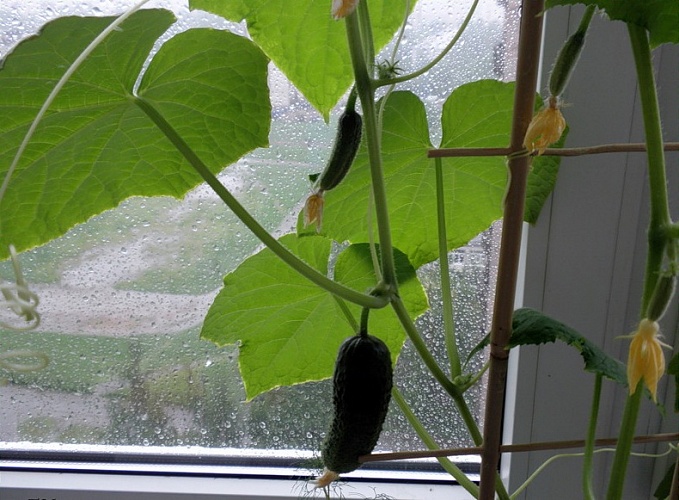
Such different varieties of cucumbers
Vegetables grown right in the apartment no longer seem like a curiosity - more and more summer residents do not want to part with juicy and tasty fruits for the winter, which they are used to during the summer season. Therefore, they begin to resort to various tricks, a kind of "life hacks", such as growing vegetables on the windowsill. Among those cultures that live well in a city apartment, cucumbers can be especially noted.
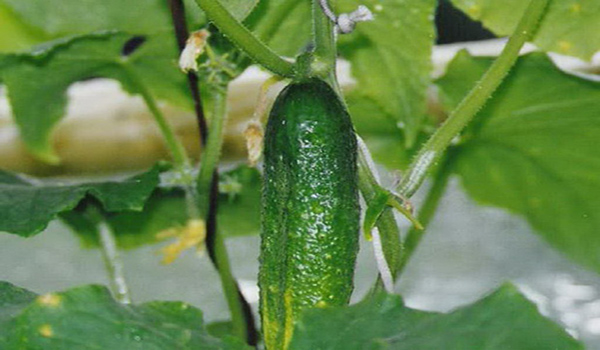

Why cucumbers?
- Firstly, these are shade-tolerant plants and they will not suffer much from a lack of sunlight in the apartment during the winter.
- Secondly, cucumbers are very convenient and efficient to maintain: they do not take up much space, but you can choose a variety with a high yield.
- Thirdly, cucumbers grow and ripen quickly - a bush can be harvested within 4-5 weeks from the moment of sowing.
But not every variety of cucumbers will have to taste living in an apartment: some of them still prefer a greenhouse to a cozy window, and therefore will not be able to fully grow and bear fruit at home. How to choose a variety?
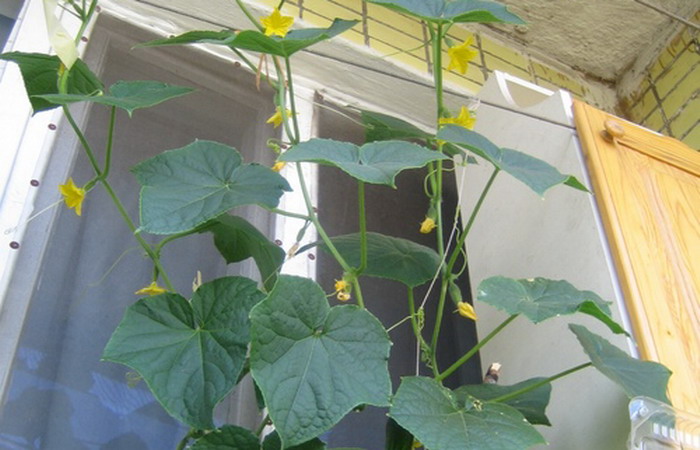

First, let's find out what varieties are:
varieties that are not suitable for homemade preparations, but are excellent in taste when eaten raw. They make delicious and flavorful salads. Very well kept, so often used for sale. Spikes of cucumbers are white.
Attention: if the spikes on the body of the cucumber are white, then this is an excellent salad variety, but such cucumbers are not suitable for canning.
| Category | Description |
|---|---|
| Parthenocarpic | Varieties that do not require pollination. They produce fruits that do not contain seeds. |
| Self pollinating | Varieties that have both pistils and stamens in the same flower. They pollinate on their own, while their fruits are with seeds. |
| bee pollinated | Here, too, everything is clear from the name. In order for the ovary to appear, bees are needed to pollinate the flowers of the plant. Alas, insects are indispensable here. |
| F1 hybrids | "Kids" of the first generation, obtained by crossing two different varieties. They are popular among gardeners, because they are distinguished by a plentiful harvest, good taste of fruits, they tolerate fluctuations in growing conditions well. |
| Salad | |
| Pickling | Varieties, the best use of which is the preparation of homemade preparations, since the peel of such fruits perfectly absorbs the brine. It is better to preserve them immediately after harvesting, since the keeping quality of such varieties is minimal. Thorns on the body of the fetus - black |
| Universal | Such cucumbers are suitable for everything: they can be salted, pickled, and eaten raw. Their spikes are black |
Also, varieties of cucumbers are divided according to the type of conditions and place of cultivation (for closed or open ground), according to the shape of the stem (liana, bush). They are also classified according to the size of greens (gherkins, pickles and others).
Zelenets is the name of the cucumber fruit.
![]()
![]()
Choose a variety
How to choose a variety of cucumbers to create a greenhouse on your windowsill? Everything is very simple:
- Cucumbers on the windowsill should take up as little space as possible so as not to interfere - that is, choose bush varieties, and not those that, when growing, will turn into a giant liana.
- Choose a variety with a good yield so that it brings more benefits (or rather, fruits) to the gardener.
- Choose varieties that are unpretentious to growing conditions: in winter, due to central heating, it is very dry in apartments, and cucumbers love humidity. In addition, in the winter season, plants may experience a lack of light.
- Stop your choice on hybrids - such varieties bear fruit well and are tolerant of negative impacts environment.
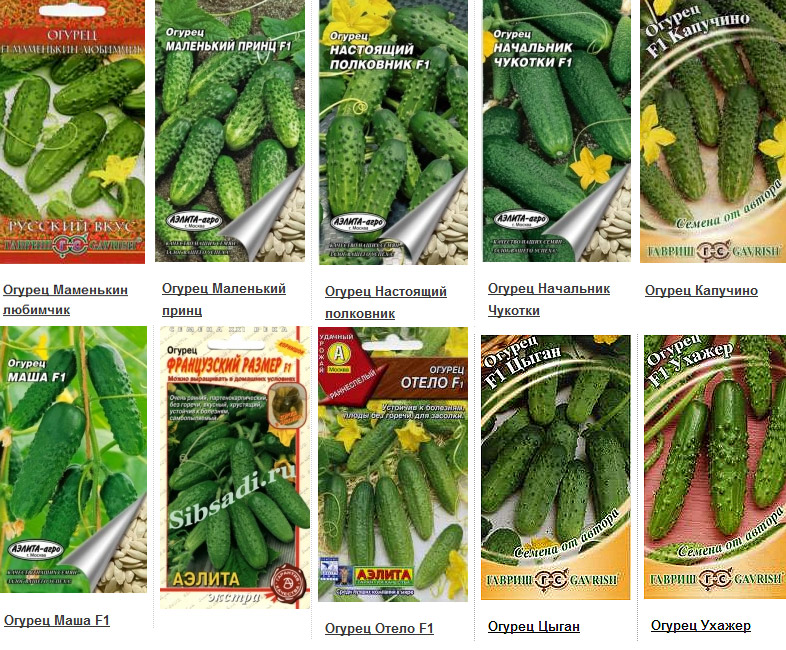

The variety must be self-pollinating or parthenocarpic - you won’t breed bees in winter so that they pollinate your plants?
Recommended varieties of cucumbers for growing on the windowsill
The following varieties of this herbaceous plant have already been tested by time, or rather, summer residents.
| Variety | Photo | Characteristic |
|---|---|---|
| The name of the hybrid has already said everything about this variety - it was created specifically to settle in your window. Flowers are predominantly female. You can enjoy the first cucumbers already 55 days after the seedlings have sprouted. At the same time, the yield is quite high - from 1 square meter remove up to 15 kg of cucumbers. Zelentsy are smooth, dark green, shiny, up to 16 cm long. Very tasty fresh. A hybrid that is not afraid of diseases, shade-tolerant, easily tolerates temperature changes and does not lose ovaries | ||
| A hybrid variety with a name once worn by a great empress. Mid-early variety (ripening period of about 50 days), bearing fruit for a long time. The bushes are medium in size, give dark green greens up to 23 cm long. The yield is good - about 18 kg of juicy cucumbers can be “removed” from 1 square meter. Low-susceptibility to diseases, frost-resistant, shade-tolerant hybrid variety. Used for home canning, but tastes best when consumed fresh. | ||
| A hybrid that does not require pollination, mid-season. Weakly climbing plant of medium size, bears fruit abundantly and for a long time, little susceptible to diseases. Gives fragrant, robust fruits of modest size (up to 10 cm long) with a light fluff. The yield is average - from 1 square meter you can collect up to 9 kg of cucumbers, which are well preserved and no less wonderful in taste when eaten raw | ||
| Not requiring pollination, early maturing hybrid variety with female flowers. The fruits are medium in size, smooth in the form of a cylinder up to 18 cm long with a bright taste, not bitter. Used for salads | ||
| A long-known old medium-branching hybrid variety for salad purposes. The yield is good. It begins to bear fruit early - as early as 45 days after the appearance of sprouts. The fruits are decorated with white thorns, large (up to 22 cm long), with a white fluff, well stored. Relatively cold-resistant hybrid variety, not afraid of diseases and cold weather | ||
| Frost-resistant mid-early variety that does not need pollination. Strongly branched plant, not limited by the level of growth. Prickly cucumbers are suitable both for preservation and for eating raw. The size of cucumbers is up to 15 cm, dense, bumpy, dark green fruits | ||
| Early maturing vigorous variety of medium climbing level. Fruits with tubercles, not large, up to 12 cm long. The pulp is not bitter, dense, the skin is tender. The hybrid is not afraid of diseases, unpretentious. Greens are used for making salads | ||
| Parthenocarpic hybrid variety. The ripening time of greens is about 45 days. Productive, low susceptibility to diseases. Cucumbers are not bitter, ripen early. They are canned and eaten raw. | ||
| Fast maturing (up to 38 days after the appearance of sprouts), self-pollinating hybrid. Weakly branched, indeterminate. Cucumbers are small (up to 82 grams), striped, cylinder-shaped, with a black fluff. Suitable for salting, pickling, salads |
Growing cucumbers on the windowsill
Now, in order for cucumbers to please us with their fruits, their seeds need to be planted and grown. Having decided on the variety, we proceed to this responsible event.
- Let's start by preparing a container for plants and soil. Choose oblong boxes or pots for cucumbers at the rate of at least 5 liters in volume per 1 plant. Make drainage holes in each container.
- We prepare the soil: for this we mix garden soil, sand, rotten sawdust, ash, humus in equal proportions. Place the prepared soil in the oven and warm it up to destroy insect eggs and infections in it. You can also buy store-bought soil.
- Fill the pot with soil 24 hours before sowing and water well.
- Make a depression in the soil (about 1.5 cm), place the seed there. We plant the prepared seeds either germinated or dry, as it is more convenient. Sprinkle with soil.
- We close the boxes or pots with cellophane film and place them in the room where the air temperature is kept at least +25 degrees. Can be placed above a heating radiator.
- We are waiting for the first shoots to appear. When the plants hatch, remove the cellophane and put the boxes with seedlings on the windowsill. Now the air temperature should be about 20 degrees.
- When the plants grow a little, you need to shape them. To do this, when the bushes have 4-5 leaves, you need to start pinching the top so that the side branches-lashes grow (they are left about 2-3 per bush).
- Then the lashes will have to be pinched (this is done over the 10th leaf). According to this principle, the plant is further formed.
- Do not forget to tie up the whips so that the whole plant has enough light. Excess mustaches are cut off.
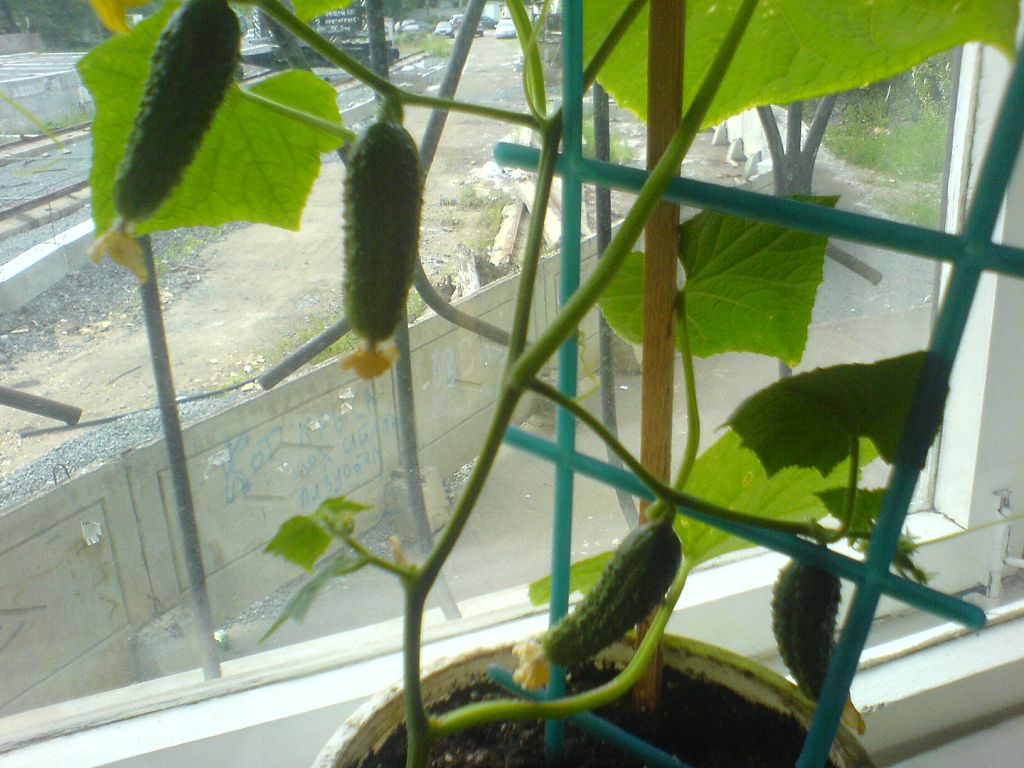

Cucumber Care
How to care for cucumbers living on your windowsill so that they give you a bountiful harvest? Everything is simple here:
- Some varieties of cucumbers are tolerant of some shading, but it is still better to fully provide the plants with life-giving light. Therefore, if you grow cucumbers on a window in winter, then from November to February, in the "darkest" months, additionally highlight the plants.
- Periodically feed cucumber bushes with organic fertilizers.
- Cucumbers are often watered with warm settled water - these plants love moisture. If the air in the house is dry, then saucers with water are placed near the plants to moisten and the bushes are periodically sprayed.
- Cucumbers love warmth, so do not put them in a cold room or a room that is often ventilated.
- If the cucumbers began to bear fruit, then the crop should be harvested regularly, preferably daily, so that the bush does not waste energy on ripened fruits and forms new ones, delighting you with fresh cucumbers for as long as possible.
A good fertilizer is a fermented infusion of banana skins, diluted with water.
Video - Planting cucumber seeds
One can envy those who have their own plot of land, even a small dacha! Owners of their own homes can always enjoy vitamins carefully grown in gardens.
But you also want to pamper yourself and your family with a salad of fresh cucumbers, your own, and not store-bought ones, even in a dank, cold time. Store-bought ones are expensive, and their taste is not at all the same.
There is an exit! We can grow cucumbers on the windowsill.
- In any apartment, you can create your own mini-garden from indoor cucumbers. To do this, you need quite a bit: suitable seeds, knowledge of the rules of planting and care, and, of course, desire.
The apartment garden on the windowsill requires very simple care. Even inexperienced, novice amateur gardeners will cope with this.
Although cucumber crops are particularly demanding, it is quite possible to create suitable conditions for them on the windowsill.
Choosing the right variety
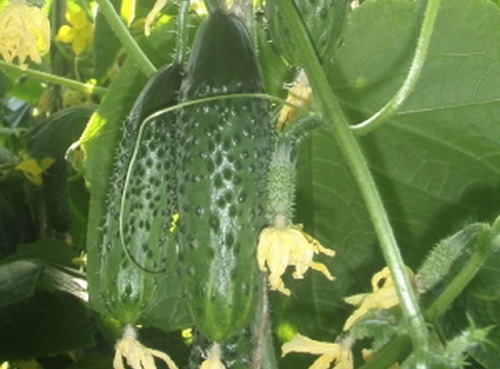
There are varieties of cucumbers specially created by breeders intended for breeding in apartments. Almost all of them are hybrids that can do without insect pollinators.
These are female-type cucumbers, parthenocarpic hybrids capable of setting fruit in the absence of pollination.
- The ideal varieties of cucumbers on the windowsill will be medium climbing and bush species. They have more than enough space even in small areas.
It is best to choose shade-tolerant varieties, those hybrids that do not care about winter weather and indoor lighting.
The best varieties of indoor cucumbers
♦ Shchedryk. Early ripening cucumbers (the first crop will ripen 40-45 days after sowing).
Cucumbers grow up to 12 cm and they grow in bunches of 6-8 pieces. Each of the home cucumber plants can bring the owner up to 20-25 fruits.
♦ Crunch. The harvest of small cucumbers will please the owner in 45-50 days. Small fruits grow in bunches of 5-7 pieces.
The harvest is plentiful, one cucumber bush can bring up to 40 cucumbers. Khrustik is vigorous, it can even be allowed to grow as a beautiful liana along the window.
♦ Bianca. Cucumber-gherkin is ideal for pickles and marinades. On each knot, they can form up to 6-7 fruits of a sweet taste.
Bianca is characterized by long fruiting and good resistance to stress and disease.
♦ Masha. This variety of cucumber on the windowsill has a powerful and strong stem. Small cucumbers ripen together, their flesh is devoid of bitterness and quite dense.
They ripen in groups of up to 5-6 pieces on one knot. The length of each fruit is up to 8 cm.
♦ Regatta. The variety is high palatability, it is resistant to ailments and has an excellent yield (gives the owner up to 40 fruits weighing 150 g from each plant). This is the perfect species for indoor growing.
For a rich garden on the windowsill, other parthenocarpic varieties of cucumbers are also perfect: Photon, Marinda F1, Kukaracha, April, Zozulya, Claudia F1, Gribovchanka, Stella, Debut, Room, Home.
There are also home varieties that need pollination, the most delicious of them: Ladoga, Frigate, Manul, Marathon, Olympics, Northern Lights.
With them, it will be necessary to plant any male pollinator variety: Hercules, Ermine, Gladiator. If necessary, you can pollinate the plants yourself with a soft brush.
An important event - planting cucumbers
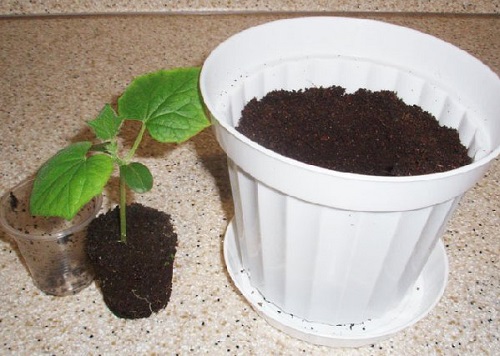
♦ Choose and prepare a place. Green home cucumber crumbs need warmth and good lighting, so it is better to create a cucumber garden on the south or east windows.
- If the window sill is too cold, place pieces of isolon, foam plastic or boards on it (otherwise the seedling roots may freeze).
- Cover the window with polyethylene (this will eliminate the appearance of drafts when airing our mini-garden). Be sure to close all the cracks in the windows.
- You can stick reflective films on the glass, install mirrors or foil next to the pots. Such a coating will create more comfortable conditions for young plants.
- Cucumbers also need good moisture. It can be provided by containers filled with water, trays of moistened gravel / pebbles, placed next to the seedling boxes. Well increase humidity and wet rags on batteries and special humidifiers.
Provide artificial additional lighting (our winter is characterized by short daylight hours). Cucumbers on the windowsill in winter should be illuminated for at least 10-12 hours, in early spring 4-6 hours additionally.
♦ Where to plant. Cucumbers grown on the windowsill can be placed in any container with a volume of at least 8 liters per plant. In containers, a couple of holes should be made at the bottom for free access of air and drainage of excess liquid.
On the bottom, place drainage from pieces of broken brick, tile, expanded clay, gravel or foam. The drainage layer should be about 3-4 cm, cover it with soil on top.
- Before filling the containers with the soil mixture, the cucumber boxes should be thoroughly washed with a weak solution of potassium permanganate and then doused with steam. This is necessary for additional disinfection.
♦ Soil for planting. How to grow cucumbers on the windowsill, what land do they need? Homemade cucumbers love loose and fertile soil.
For their cultivation, you can use the purchased ready-made soil (universal or mixture for pumpkin). The soil can be made with your own hands.
We need the following mixture:
- Compost 40%.
- Peat 30%.
- Soddy soil 20%.
- Wood sawdust 10%.
It is also necessary to add urea to the prepared soil (the volume of an incomplete matchbox per 10 liters of the finished soil mixture) and potassium sulfate with superphosphate (the volume of two matchboxes).
A mixture of soddy soil, manure humus, peat and sawdust (1 part each) is also suitable for cucumbers on the windowsill.
Add nitrophoska (1 tbsp), wood ash (1 cup) and urea (1 tsp) to a bucket of this mixture.
- Soil consumption is not less than 5-6 liters for each cucumber plant. Or follow this rule: 5-6 bushes are planted on one seedling box 60-70 cm long.
For prevention and disinfection, the soil should be poured with a weak (pale pink) solution of manganese and heated in the oven.
Then mix the soil thoroughly and pour it into the container, not reaching 5-7 cm to the edge of the containers. Before planting the seeds, water containers with soil with hot water at a temperature of + 60-70 ° C.
- On the advice of experienced gardeners, grease the edges of the container where cucumbers will grow with some ointment with a pungent odor (for example, Asterisk balm). A sharp aroma will scare away the appearance of one malicious cucumber pest - a sprout fly that can be brought with the ground.
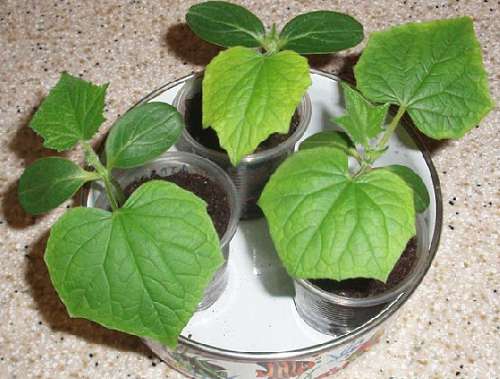
♦ When to plant. If your plans are to see fresh cucumbers on the New Year's table, plant seeds at the end of October.
Seeds sown at the end of December will produce a crop around the end of February. If you need vitamins in the spring (in March), sow your garden in January.
And if you want to save on electricity and grow cucumbers without additional illumination, then it is best to sow the seeds on February 20-25.
Keep in mind that not much time passes from the time of sowing to the start of collecting vitamin fruits (30-50 days). It depends on the type of cucumber.
♦ Cooking seeds. Seeds for growing cucumbers on the windowsill are different. Their preparation for planting is carried out depending on the type of purchased seeds:
- hybrid seeds. The fact that the variety is hybrid can be understood by marking F1 in the name. These seeds are sold already fully prepared for sowing. Additional activities are not required.
- Instructed seeds. On sale you can find multi-colored cucumber seeds (blue, green, red). Their pretty color is the result of processing with polymers that form a reliable protective shell. Polymers stimulate plant growth and protect them. Such seeds also do not require pre-treatment.
- Dried seeds. These types of seeds are covered with a special peat-mineral mixture, which forms a protective shell. Pelleted seeds are more economical to sow, they rarely need to be thinned out, and they do not require additional preparation for sowing.
All other seeds of varietal cucumbers should be kept for 5-6 hours in a weak solution of immunocytophyte (tablet per 100 ml of water).
You can also use a light pink solution of manganese or wood ash (a teaspoon per 100 ml of water).
Before soaking, the seeds should be heated in a thermos for about 2-3 hours in hot water at a temperature of + 45-40 ° C.
♦ Seeding. Prepared cucumber seeds are best grown in small cups. Carefully place each seed in separate containers in a small recess, cover with a damp bandage or gauze on top.
Put the cups in boxes, cover the boxes themselves with glass or film. Place them in a warm place and keep at a temperature of + 23-25 ° C.
- After 2-3 days, the first cotyledons will unfold in the cucumbers. Immediately after the emergence of seedlings, we remove the coating and transfer the container with our seeds to the selected and prepared window sill.
Cucumbers at home must be placed on the windowsill so that their upper part faces the window.
The optimum temperature for young seedlings: during the day + 22-26 ° C, at night + 17-22 ° C.
After 20-25 days, young crops need to be moved to larger containers already on permanent habitats (for this event, choose cloudy days).
Before transplanting, pour the soil with warm water. Seedlings are transplanted with a clod of earth (take care of the leaves of young plants - they are still very fragile).
Let's take care of our cucumbers
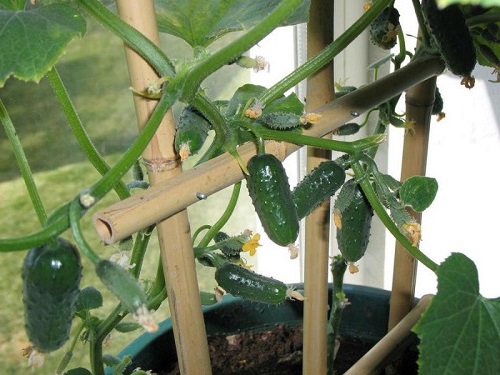
♦ Garter. As soon as our cucumbers grow 5-6 leaves, we need to stick pegs next to the seedlings. Or you can pull twine or wire at a height of 1.5-1.8 m from the boxes. Growing cucumber tendrils should be tied to it.
- To stimulate the growth of young plants, cut off the top above the 10-11th leaf, also regularly pinch all side shoots as soon as they grow by 20-30 cm. Every week, young cucumbers need to be removed growing extra tendrils.
♦ Backlight. Daytime, phytolamps or energy-saving lamps for additional illumination of our garden should be placed at a height of at least 5 cm from the upper crown of plants.
As they grow, the lamps should be raised higher.
Illumination can be used from the first moment of germination. Turn it on during the day from 7-8 in the morning for 6-8 hours. Don't forget to turn off the lights at night.
♦ Watering. Cucumbers should be watered moderately, without waiting for the soil to dry completely. Without additional illumination, the frequency of watering is once a day, with additional illumination a couple of times.
Water must first be defended, and its temperature should not exceed + 23-25 ° C.
- Adult plants can be watered less often - weekly from 2-3 times. Watering cucumbers is best done in the morning.
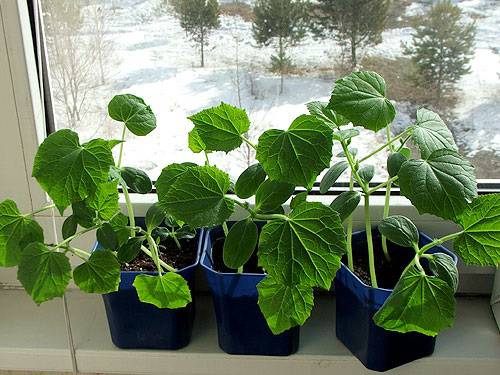
♦ Top dressing. When growing homemade cucumbers on the windowsill, young seedlings (until they reach 20-25 days) should be fed twice:
- 1.5-2 weeks after the first shoots. Use a solution of urea (a teaspoon per 2-3 liters of water). Consumption of a glass of solution for each bush.
- A week after the first meal. Suitable nitrophoska (teaspoon) or wood ash (tablespoon) for 3 liters of water. Consumption: a glass for each plant.
Additionally, seedlings (especially in winter) can be flavored with an infusion of banana peel, diluting it in 10 parts of water.
Top dressing for adult cucumbers should be done depending on their well-being. If the bushes have a weak stem and stunted leaves, cucumbers need top dressing.
- On average, adult cucumber plantings should be fed once a week, as soon as they reach the age of 1.5-2 months.
You can arm yourself with purchased complex mineral supplements or liquid organics ("Epin", "Radogor", "Bucephalus").
Cucumbers should also be fed with natural fertilizer (especially during the formation of ovaries).
Wood ash is ideal for this (mix 100 g per liter hot water and insist a day or two). Plants must be watered before fertilizing.
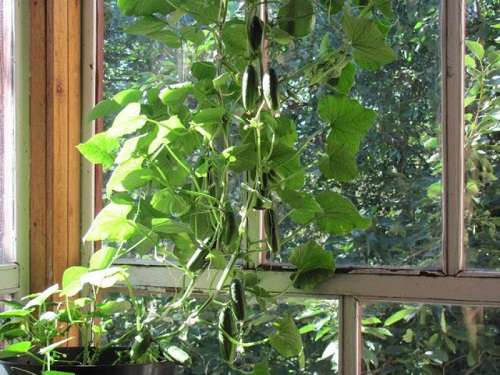
♦ Important nuances. In the process of growing cucumbers on the windowsill, learn a number of simple rules, their obligatory implementation guarantees a plentiful and friendly harvest of green vitamins:
- Don't let the cucumber soil dry out!
- If the roots of cucumbers appear on the surface of the soil, immediately sprinkle them with fresh soil.
- In the case of the active appearance of female flowers, cut off some of them, otherwise the fruits will form very slowly.
- Do not leave ripe cucumbers hanging on the bushes - they will continue to take nutrients and will not allow other fruits to fully ripen. The more often ripe cucumbers are removed, the more of them will be formed.
Subject to all the rules and careful care, your cucumber garden will show excellent yield results, on average, up to 30-35 strong, vitamin-filled cucumbers can be harvested from one plant.
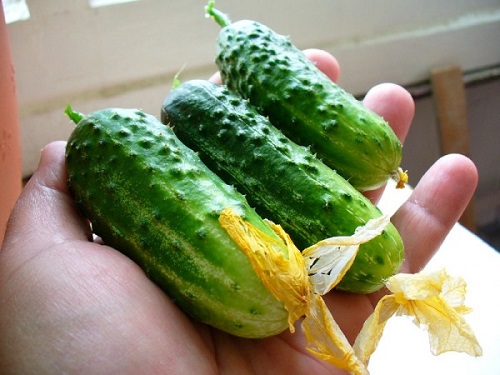
♦ Harvest. Ripe cucumbers should be cut off at the age of 1-1.5 weeks. Do it every day.
Sick or deformed fruits should be harvested as soon as they form.
Harvesting a tiny crop will bring real pleasure to the owner of a cucumber mini-garden!
Instead of a window sill - a balcony!
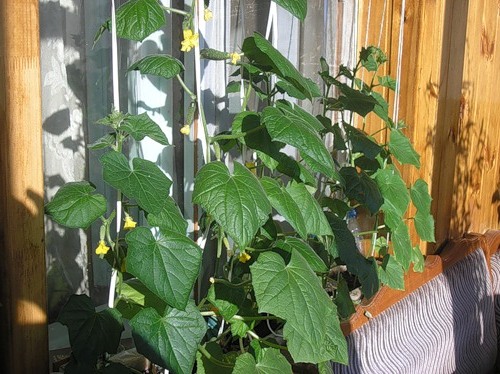
A cucumber garden can be successfully placed on a covered balcony, terrace or loggia. Cucumbers on the balcony are best placed in the corners of the room or along the walls.
Thus, the plants will be more protected from possible drafts.
- For the successful cultivation of cucumbers in such conditions, it is better to select balconies / loggias in the south or southeast direction (as well as when arranging cucumbers on the windowsill). If the balcony faces north, it will be too dark for young cucumbers and they may not grow.
If your balcony is well insulated, you can grow cucumbers on it all year round. But cucumbers love not only heat, but also light.
If you have the means and opportunities, install additional lighting on the balconies (but be aware that you will need several lamps, and the energy consumption will increase - after all, there is much more space on the balcony than on the windowsills).
Or plant seeds for seedlings at the beginning of the spring period, so that you can harvest earlier (before the short day).
For the success of the intended event, adhere to the following rules:
- Keep your garden regularly hydrated.
- Balcony garden needs good protection from insects and drafts (cucumber varieties adapted specifically for home cultivation are very susceptible to diseases that various insect pests carry).
- Although cucumbers love light, they should not be allowed to overheat and dry out the leaves. To do this, install protective translucent curtains on the glass of the balconies.
- Since we will have more cucumbers on balconies / loggias, it is better to use a nylon mesh or a lattice of slats as a garter.
The preparation of the soil, seeds, their planting and care is carried out according to the same rules as in the case of arranging a garden on a windowsill.
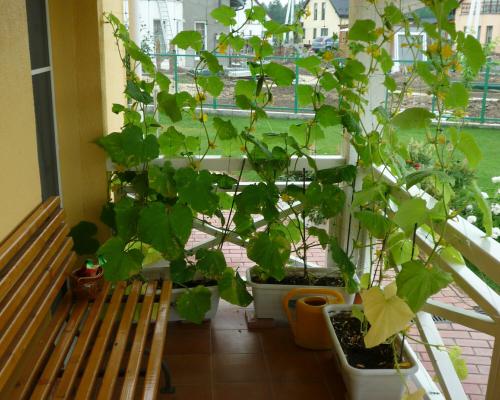
If you think that winter is the time for a gardener to relax, then you are mistaken. Enthusiast gardeners will always find something to do even in the cold season. Even if there is no access to a greenhouse, you can grow it in an apartment in a pre-equipped corner or on a windowsill. Most often in such cases, strawberries, greens, and tomatoes are grown. In this article, we will tell you about how to grow cucumbers on a windowsill in winter, having examined the main stages of such a process, from preparing a site for planting to harvesting.
The first step is one of the most important, as the wrong choice of location can negate the cultivation of cucumbers on the windowsill. The window should face south or southwest as the plants will need a significant amount of sunlight. But the winter day is much shorter than the summer day, and the plants will still need an additional source.
In this case, it is good to use fluorescent lamps, lamps. You must provide a constant supply of light to the plants for at least 12 hours a day. also make sure that drafts do not appear on the windowsill. In addition, keep the air temperature near the windowsill at a constant temperature of at least twenty degrees, otherwise the plants will develop poorly and you risk getting a bad harvest.
The choice of containers depends on how you will grow cucumbers - with or without a pick. If you are planning with a pick, then you can sow the seeds first in small plastic cups, otherwise use large pots.
Variety selection
Next, you need to decide on the variety. Not all varieties are suitable for growing cucumbers on the windowsill, because each has its own characteristics, requirements for the growing environment. Now, thanks to breeding, there are many varieties, including some that are very useful for growing on a windowsill in winter. In order to get rid of unnecessary hassle in the form of pollination of a plant, it is better to choose one of the parthenocarpic species (this is the term often written on the package with seeds, plants from which self-pollinate).
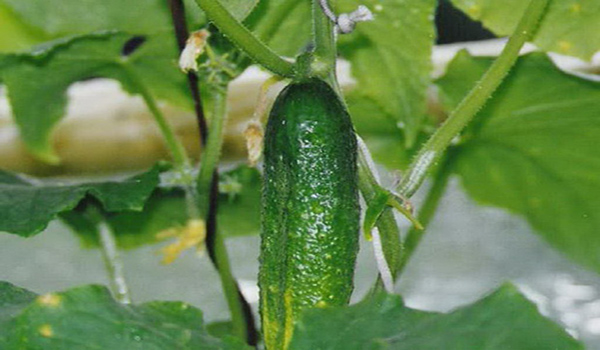
When choosing, consider the timing of fruiting. Among the early varieties, April, Murashka, Benefis, Parus are popular. There are enough of them, so the choice suitable option- an individual matter for each gardener.
There are no less mid-season parthenocarpic varieties: Athlete, Solnechny, Topolek, Stepnoy, Far East. Late varieties of cucumbers on the windowsill are rarely grown. Also, when buying seeds, pay attention to other characteristics of the variety, which are indicated on the package.
Soil and seed preparation
Soil preparation is essential for good yields. You can buy ready-made, but it’s not so difficult to prepare the soil mass yourself. To do this, you need to mix the earth from the garden (since most likely you will take it in the winter, do not use it immediately, it should not be frozen), humus, adding peat is welcome.
For preventive purposes, gardeners often add wood ash or lime this mixture. Also, do not forget about the required dose of fertilizers. Pots or boxes with seedlings should be with drainage holes, a thin ball of fine gravel should first be located at the bottom of the containers (it can be replaced with brick chips), and the soil mixture is poured on top of it.
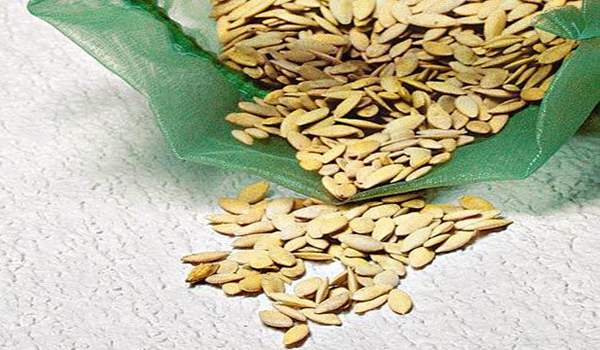
Since the cucumber is a climbing plant, you need to take care of its comfortable growth in the future: prepare devices for fastening the plant, for example, you can use wooden pegs about half a meter long.
After preparing the soil, you need to take care of the suitability of the seeds for use. Try to select the best seeds to make sure they germinate. Often the seeds are treated with various chemicals in order to disinfect, you can use a solution of potassium permanganate for this (it should be dark pink).
To speed up the growth of grains, wrap them in a damp cloth and place them in a warm place for a day or two. When they turn up, you can sow. Since cucumbers will be grown on the windowsill, and not in the open field, it is not necessary to harden the seeds.
Care
Cucumber is probably the most unpretentious plant. which can be grown in the winter on the windowsill in own apartment. As already mentioned, the most important factors for the successful development of plants are light and heat. And, of course, moisture. In order for the fruits not to turn out bitter, they need abundant watering, and every day.
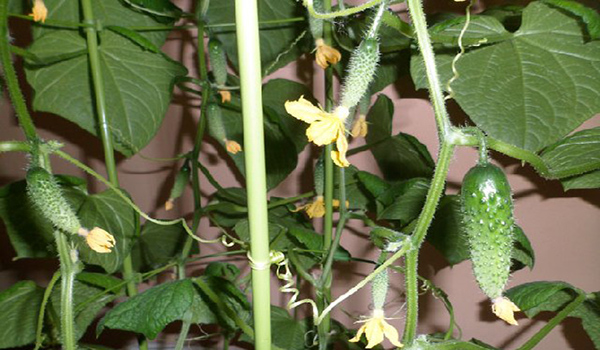
Moreover, it is necessary to maintain suitable humidity. In most cases, in a way where it is almost always hot, so spray the plants twice a day. When enough leaves are formed (5 or more), all whiskers should be removed. If necessary, apply a dose of mineral fertilizers.
Pinch cucumbers during (after the first ovaries appear). And do not forget that over time the plants will need free space, so promptly guide them in the right direction by tying them to a support.
fruit picking
Harvesting is the final and most enjoyable stage of growing cucumbers on the windowsill. It is advisable to pick fruits of medium size, so the plant will be less depleted. And the taste will only get worse over time. Sometimes a very good harvest is possible - up to 15 cucumbers from one bush, but this is with sufficient care. And from a whole “plantation” on the windowsill, the harvest will turn out to be very impressive, given that it is winter outside.
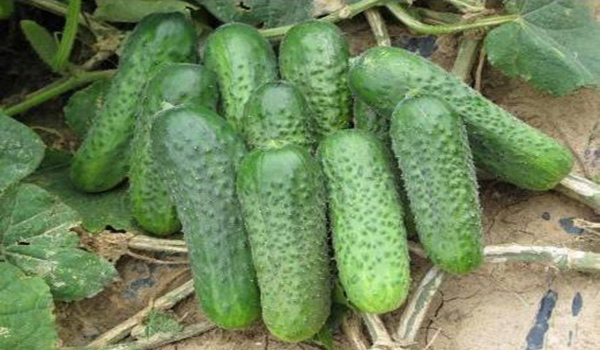
If you still have questions about growing cucumbers on a windowsill in winter, you can watch video tutorials on growing cucumbers on the Internet. After that, you will surely be able to independently engage in gardening on the windowsill and treat your family and friends with delicious vegetables in the middle of winter.
Video "Growing cucumbers on the windowsill at home"
The video shows how you can effectively grow cucumbers at home on the windowsill. Take a look and make sure that growing cucumbers in such conditions does not pose great difficulties.
Climatic conditions in middle lane Russia is not allowed to grow cucumbers from seeds in open beds without additional film shelters. This popular vegetable crop is very demanding on heat and light. With frosts down to -1 degrees, young shoots can easily die, and with shading, adult plants will not bear fruit well. Therefore, growing cucumbers in a greenhouse is the most popular and common option among Russian vegetable growers.
Cucumbers in a greenhouse in winter and summer can produce a high yield if the plants are provided with suitable conditions. This means that if you have a heated greenhouse, even in the winter months you will be able to please your loved ones with fresh vegetables grown without chemicals.
Before you start planting, you need to choose varieties of cucumbers for greenhouses, because not every variety is suitable for growing in such conditions. For example, bee-pollinated varieties will have to be manually pollinated daily (insects fly into the greenhouse reluctantly, and in winter they don’t exist at all), otherwise the ovaries will fall off. Most Popular:
- Self-pollinated high-yielding hybrids of cucumbers: Hercules F1 (salad), Emelya F1 (pickling), Dynamite F1 (universal), Zozulya F1, Anyuta F1, Picnic F1, Midget F1, Hummingbird F1, Swallowtail F1, Calendar F1, April F1, Courage F1, Lukhovitsky F1 and others.
- Yields and at the same time quite unpretentious varieties: Moscow greenhouse, Zarya, Manul, Pomegranate, Surprise 66.
- The following varieties are distinguished by special shade tolerance and adaptability to low humidity: Marfinsky, Relay, Domashny, NK-mini, Willow, Regatta, Rykovsky, Russian.
photo of greenhouse cucumbers
Detailed technology for growing cucumbers in a greenhouse
For germination of cucumber seeds, a temperature of + 22 + 25 degrees is recommended. Therefore, if the greenhouse is unheated, of a film type, sowing seeds is carried out at home in the first half of April in order to transplant ready-made seedlings into the greenhouse by mid-May. In heated greenhouses, cucumber seeds can be sown at any time of the year.
Soil preparation
Cucumbers love fertile soils saturated with organic fertilizers. So that the cultivation of greenhouse cucumbers brings good results, prepare the soil mixture in advance: 2 parts of humus and peat, 1 part of sawdust (better than old ones), wood ash 3 tbsp. and nitrophoska 1 tbsp. You can buy ready-made soil with fertilizers. Level the surface of the soil and sprinkle mineral fertilizers on top. Then cover the surface with a film and leave for a couple of weeks to absorb the fertilizer. This will help protect the seedlings from cucumber diseases, increase the yield and improve the taste of the fruit. Video about growing cucumbers in a greenhouse
Calibration and disinfection of seeds
It is best to grow cucumbers in a greenhouse from seeds that are 2-3 years old, as they will provide the highest yield. Calibrate seeds manually by removing diseased and empty seeds. Then you should disinfect the seeds from diseases and pests by putting them for 12 hours in a cloth moistened with aloe juice or a solution of trace elements (add boric acid and copper sulfate at the tip of a knife to a liter of hot water, as well as a teaspoon of nitrophoska). Then rinse the seeds in running water and lay them between layers of damp gauze to place in the refrigerator for hardening. Hardening is carried out at a temperature of about 0 degrees for a week, do not forget to moisten the gauze from time to time.
Growing seedlings
Seedlings are recommended to be grown in small pots or plastic cups. Each seed is placed one by one in a pot to a depth of 2 cm, covered with a layer of soil and covered with a damp cloth on top so that the top layer of soil does not dry out. You can sow seeds for seedlings for 10-15 days - planting cucumbers in a greenhouse in a conveyor way will provide you with a continuous harvest throughout the year.
Photo of growing cucumbers in winter in a greenhouse
Until the first shoots appear, the temperature in the greenhouse should be maintained at +25 degrees, and with the advent of sprouts for 5 days, the day temperature should be reduced to +15, and the night temperature to +12 degrees. Seedlings should be watered once every 2 days, periodically feeding with a solution of mullein (at the rate of 1:6). After feeding, wash the seedlings with clean warm water.
Transplanting seedlings and caring for cucumbers
A month later, transplanting seedlings begins. In rack greenhouses, seedlings are planted on racks covered with soil, while in other types of greenhouses, even ridges are simply formed. You can plant plants in ridges directly in pots, deepening into the ground by ¾ of the height of the pot. Between plants, the distance should be at least 20 cm, and between rows - at least 90 cm.
photo of cucumbers in a greenhouse
During the day in the greenhouse, the temperature should be maintained at + 25 + 30 degrees, with mandatory ventilation on sunny days, and at night - within +15 degrees. When the third true leaf appears, the first top dressing is done with fertilizers, the second top dressing is carried out at the beginning of flowering. During fruiting, you can feed the cucumbers 4 times with a solution of mullein, or a solution of chicken manure. Before flowering, it is recommended to water cucumbers every 5 days, after flowering - every other day, but if you notice that the leaves have begun to wilt, this is a signal for urgent watering. As the plants grow, they will need to be carefully tied to two wires stretched across the top of the greenhouse.
Features of growing cucumbers in greenhouses in winter
Before growing cucumbers in a greenhouse, it is worth considering the most likely difficulties that you will face. The first problem is the lack of moisture in the air due to stove or water heating of greenhouses. Since cucumbers are very moisture-loving, you will have to constantly take care of maintaining comfortable air humidity. Arrange baking sheets, water barrels, moisten the floor, pipes, spray plants with a spray bottle, etc.
Video about growing cucumbers in a greenhouse in winter If you are interested in growing cucumbers in winter, in December-January, then start sowing seeds at the end of September, and plant seedlings at the end of October. But keep in mind that due to the lack of sunlight in January-February, growing cucumbers in a greenhouse in winter is almost impossible. without additional artificial lighting. With an increase in illumination, the quality of fruits improves and the content of ascorbic acid and sugars in fruits. It is advisable to hang the lamps first at a height of 50 cm above the plants, and as they grow, raise the lamps higher, up to 1.5 m.
Be sure to monitor the temperature regime in the greenhouse: there should be no sharp daily temperature changes and a temperature drop of less than +10 degrees, otherwise the leaves will actively grow, but the fruits will stop pouring, and the root system will not be able to absorb water.
Now you know how to grow cucumbers in winter, which means that by the New Year's table you will have your own harvest of delicious homemade cucumbers!
orchardo.ru
How to grow cucumbers in the winter in a greenhouse
Fresh cucumbers on the table New Year or late autumn, grown with their own hands, will cause pride in the gardener and envy of the neighbors. But the weather conditions in our country do not allow harvesting in the beds all year round, since this vegetable crop needs warmth and good lighting. Already at a temperature of -1 ° C, it dies, and in the absence of light it does not bear fruit well. Therefore, growing cucumbers in a greenhouse in winter is the only option if you want to eat this vegetable grown without harmful chemicals in winter. It is possible to achieve its good harvest in a winter greenhouse, the process itself is not much different from growing in open ground. But in order to avoid mistakes, you need to know the features of the technology.
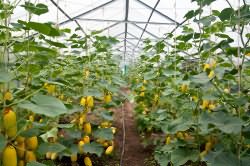
To maintain an acceptable temperature in the winter greenhouse, it is recommended to lay biofuel in the soil before planting cucumbers.
What materials and tools are needed to grow cucumbers in winter?
To harvest cucumbers in a winter greenhouse, you will need basic knowledge of plant care, diligence, a desire to achieve your goal, as well as the following tools and materials:
- suitable seeds.
- Winter greenhouse with heating.
- Greenhouse ventilation system.
- Greenhouse lighting.
- Seed disinfectant.
- Paper pots or cups.
- Organic and mineral fertilizers.
- Wire.
- Polyethylene film for covering the soil.
- Irrigation system or watering can.
- Chopper, shovel and rake.
- Thermometer.
- Preparations against pests and diseases.
The subtleties of growing cucumbers in a winter greenhouse
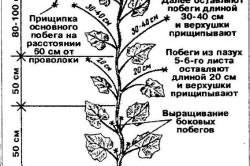
The main problem when growing cucumbers in a greenhouse is the dryness of the air in the greenhouse due to water or stove heating. Cucumbers are very moisture-loving, and maintaining optimal humidity is your main task. You can solve this issue in several ways: arrange water containers (barrels, baking sheets, buckets), moisten the floor with wet rags, or spray water from a spray bottle. Keep in mind that this will have to be done every day so that your cucumbers do not dry out. It is also important to control the temperature regime, there should not be any sharp drops or increases. This can lead to the fact that the growth of the leaves will increase, but the fruits will be small or they will not wait at all. And if the temperature is constantly above normal, it will be difficult for the root system to absorb water. The lack of natural light will also need to be compensated with the help of lamps. This is especially true during the darkest winter months - January and February. With a long daylight hours, the quality of cucumbers in a winter greenhouse will become better, as the percentage of sugar and ascorbic acid increases. Lamps should be hung at a height of about 50 cm when the plants are small, and raised higher in accordance with the growth of seedlings. If you provide a good temperature regime for cucumbers in the greenhouse in winter, then in summer and winter you will get a high yield in the greenhouse. Therefore, in the room where you grow them, there must be a heating system. If it is absent, then seedlings can be planted no earlier than April, since the most suitable temperature for this healthy and tasty vegetable is about + 25 ° C. Start sowing seeds for seedlings no later than September, so that by January sufficiently grown seedlings can be planted in a greenhouse.
How to choose the best seeds for growing cucumbers?
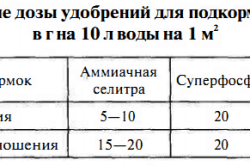
Before planting, you need to select the seeds. It depends on them whether there will be a yield, how much work you will have to apply when growing. Not all varieties are suitable for a greenhouse, but only special ones. It is better not to buy bee-pollinated varieties, because in winter the bees sleep, and in the spring they almost never fly into the greenhouse. If you still planted such varieties, you will have to pollinate them manually, otherwise all the ovaries will fall off. To do this, you need to pick a male flower, tear off the petals from it and put it in a female one. So the pollen from the stamens of the male flower will fall into the stigma of the female. In order not to get confused, already pollinated flowers are marked by tearing off one petal from them.
Varieties that have high yields and are unpretentious in care: Pomegranate, Dawn, Surprise 66, Manul. Several varieties can be planted at low humidity and in the shade: Marfinsky, Willow, Relay, Home, Russian, Regatta, NK-mini. But under better conditions, the result of your efforts will be much higher. Self-pollinated hybrids are now very popular. They are quite high-yielding and do not require complex care. For example, Hercules (good in salads), Liliput, Emelya (recommended for salting), Zozulya, Picnic, Dynamite, Hummingbird, Lukhovitsky, Anyuta, Calendar, Swallowtail, April and others.
Soil and seedling preparation
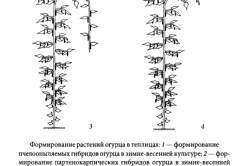
Cultivation of cucumbers should begin with the preparation of the soil and seedlings. This juicy vegetable crop prefers land saturated with fertilizers, mostly organic. Mix 2 parts of peat, humus (2 parts), wood ash (3-4 tablespoons), nitrophoska (1 salt spoon) and old sawdust (1 part). Ready-made soil sold in stores is also suitable. Level the soil and sprinkle mineral fertilizers on top, tamp well. Leave in this state for several weeks, previously covered with a film. This method of preparing the soil in a winter greenhouse will help absorb fertilizers, protect against diseases, and increase the yield and taste of fruits. It is best to plant those seeds that have lain for 2-3 years. But it is important to properly prepare them, sort them out and throw away empty, diseased ones and treat them with a disinfectant solution. This will help protect cucumber seedlings in winter in the greenhouse from pests and diseases.

To prepare the solution, you can use copper sulfate, nitrophoska (1 teaspoon per 1 liter of hot water) and boric acid (on the tip of a knife). Or just put them in aloe juice for 10 hours, and then rinse well. After soaking in this solution, the seeds must undergo a hardening procedure. Wrap them in a wet cloth and refrigerate for a week. Moisten the cloth periodically to keep the seeds from drying out. To grow successful seedlings, purchase paper pots or cups. Fill them with fertilized soil and stick one prepared seed at a depth of about 2 cm. To prevent the soil from drying out, cover the cups with a damp piece of fabric material. The air temperature for seedlings should not fall below +25°C. Do not forget about top dressing (for example, manure) and two daily waterings. After feeding, rinse the leaves with warm water. Plant seedlings in the winter greenhouse using the conveyor method (every day, a small batch of seeds for 10-15 days). Then your crop will ripen gradually, delighting every day with young cucumbers.
Planting seedlings and care
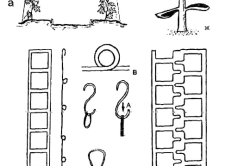
If the containers in which the seedlings are planted are paper, then they will eventually dissolve during watering. Therefore, seedlings can be buried directly in the ground without disturbing the root of the plant. Transplanting should begin in a month, but check that the temperature in the greenhouse is not lower than + 25 ° C. If you have shelving, fill it with soil and plant in it to save space. If there are no racks, make even beds with a chopper, a peg and a rope and bury the pots in the ground by about 75%. Be sure to ventilate the greenhouse, but make sure that the temperature does not fall below the required values. To do this, hang a thermometer in the greenhouse. After the appearance of the third leaf, the first feeding is performed. The second time feeding should be done when the cucumbers have already gained color. The third time they are fed during the ripening of the fruit. Use a solution of mullein or chicken manure for these purposes. In order for the cucumber lash to grow carefully, and the fruits to receive more light and not rot, pull the wire over the top of the greenhouse and tie the lashes to it. Watering is done every 5 days, and during fruiting - every other day. But if the leaves begin to turn yellow and wither, you need to water urgently, regardless of the schedule.
During the growing season loosening and weeding of the earth are obligatory.
http://youtu.be/MkA0MtQOvS4
For the entire growing season, it is necessary to make at least 4 loosenings necessary to improve the water-physical qualities of the soil. High humidity and heat in the winter greenhouse contribute to the appearance of certain diseases on cucumbers, such as anthracosis, brown spot, white rot, olive spot. The best prevention of cucumber diseases in a greenhouse in winter is proper care, the optimal combination of temperature and humidity. Use pesticides only in case of emergency, cucumbers should only bring health benefits, not harm.
Shaping and pinching
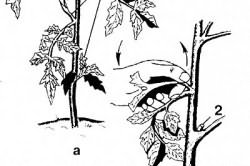
When the plants begin to grow, they must be tied with twine to the wire. A wire trellis 2-3 mm in diameter must be pulled over the ridge of the greenhouse so that it runs along the beds. The height at which the wire is attached is 2-3 meters. If you are growing trellis varieties, tie twine, a ring or loose loop (not too tight) around the stem of the cucumber, and secure the other end of the twine at the top. Don't pull too hard on the rope, you could tear off part of the stem or even uproot the bush. Watch the top grow and wrap it around the rope as needed. It is necessary to form plantings of bee-pollinated hybrids by removing stepchildren and extra flowers. When stepchildren and female flowers appear in the axils of a true leaf, they are immediately removed. This is done for better strengthening and development of the plant. Then pinch the side shoots that form in the axils of the main stem. First pinch over the second sheet, and then over the third. Thus, 3-4 leaves remain on the main stem going to the wire. On the axils of the upper leaves, 2-3 shoots remain, which are thrown over the wire and lowered down. At a height of 1 m from ground level, they are constantly pinched. Sick and yellowed leaves, side shoots that have completed fruiting are also removed.
Long-fruited parthenocarpic hybrids also form, but in a slightly different way. The rudiments of stems and flowers are removed from the main lash at a height of 40-60 cm. Small side shoots remain at the bases of the next 5 leaves, which also need to be pinched over the first leaf, and female flowers from the axils of these leaves are removed completely. In the next 5 leaves of the main lash, the stepchildren are not removed up to a height of 1.5 m, pinched over the second leaf so that only 3 ovaries remain.
http://youtu.be/OnufFoDyC5A
Weakened or poorly developing bushes that have not received sufficient watering, lighting or top dressing should not be pinched. We must wait until they gain more nutrients in the shoots, leaves and stems. Cultivation of cucumbers is quite laborious and requires money for the construction of a greenhouse with all communications. But if you think carefully about the organization of this process, then the result will bring satisfaction and tasty and healthy vegetables right from the garden at any time of the year!
VseoTeplicah.ru
What varieties of cucumbers to choose for growing in greenhouses?
Cucumber is an annual plant of the gourd family, which can grow up, twisting tendrils around supports.. Thanks to this feature, in the greenhouse it is grown on a trellis, saving space. It has a root system that is poorly recoverable after damage, so experienced gardeners recommend: use large pots for the seedling method of growing; when sowing seeds in the ground, thin out without pulling out excess plants from the ground, but cutting off their ground part; when weeding and loosening, be very careful not to hurt the roots. Appearance and the size of greens depend on which varieties of cucumbers for greenhouses are planted.
Each variety of cucumber has a different ripening time, different ways care and yield.
General characteristics of greenhouse varieties
The best result in greenhouse cultivation is given by early self-pollinated and parthenocarpic hybrids, bred specifically for use in closed ground. The difference between parthenocarpic and self-pollinating varieties is that the first greens are formed without pollination and no seeds, while the second have a pistil and a stamen in one flower and pollinate themselves, so their fruits have seeds. Both those and other hybrids can be grown in an apartment on a windowsill. Emelya F 1, Dynamite F 1, Claudia F 1, Crispina F 1, Amur F 1, Zozulya F 1, Mother-in-law F 1, Zyatek F 1 - the best greenhouse hybrids.
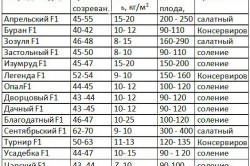
If greenhouse hybrids are pollinated by bees, the greens will turn out to be curved, ugly in shape. Bee-pollinated varieties are best planted in open ground. The method of cultivation differs only in that self-pollinated hybrids must sometimes be gently shaken. If you have chosen parthenocarpic hybrids, it is good to plant a pollinating variety of cucumbers nearby, otherwise there will be few fruits with multiple flowers. Universal varieties are distinguished by brownish or black spikes, they are suitable for salting and pickling, as well as for fresh consumption. Fruits with white spikes are best used as a salad.
Popular varieties for greenhouses
I plant, as a rule, parthenocarpic hybrids, but every year it becomes more and more difficult to choose which variety is best to plant, as breeders develop more and more new hybrids that can be planted in greenhouses and greenhouses, consider the best of them:
Emelya F 1 - early ripe (39-43 days), high-yielding, parthenocarpic cucumber variety for pickling, which was originally bred as salad. Flower type is bouquet. Zelentsy spindle-shaped from 13 to 15 cm, with white pubescence and thin skin. The variety is resistant to major diseases that affect cucumbers.
Hercules F 1 is a universal, long-branched, high-yielding (from 15 to 18 kg) parthenocarpic variety of cucumbers with a bouquet type of flowering. The fruits are cylindrical, small (from 12 to 14 cm), with brownish pubescence. More suitable for growing under film cover rather than winter greenhouses where yields can be reduced due to lack of space.
Crispina F 1 is a high-yielding, parthenocarpic hybrid with a powerful root system. It gives a large yield when grown by seedlings, three-week-old seedlings are planted in greenhouses. Greens are elongated, with large tubercles and white spikes.
Mother-in-law F 1 is an early, cold-resistant, disease-resistant parthenocarpic hybrid grown both in open ground and in a film greenhouse. Fruits from 11 to 13 cm, with large tubercles and brownish spines, are good for canning.
Stages of growing cucumbers.
Zyatek F 1 is an early ripe, disease-resistant, medium-yielding (from 5 to 7 kg) parthenocarpic hybrid. Oval-shaped cucumbers, 9 to 11 cm long, with frequent tubercles and white spikes with excellent taste. The variety is well suited for making pickles and gherkins.
Matrix F 1 is a cold-resistant, disease-resistant hybrid of the female type of flowering, it grows well both in greenhouses and in open ground. Differs in amicable return of a harvest.
Orpheus F 1 - Early ripe, high-yielding, self-pollinating hybrid. Zelentsy are cylindrical, with small tubercles and light stripes, with a complete absence of bitterness.
Zozulya F 1 is an early, cold-resistant, long-bearing, high-yielding, partially self-pollinating hybrid. The fruits are long, cylindrical, with slightly pronounced tubercles and white spikes.
Amur F 1 is a mid-early, self-pollinating, high-yielding variety suitable for growing in protected and open ground, bred in Holland. Zelentsy gherkin type, with good taste, suitable for canning.
Which varieties to give preference to, you choose, with proper care all of them will please you with a good harvest.
ParnikiTeplicy.com
Cucumber: how to choose the right variety
Today, the seed market offers us such a variety of varieties and hybrids of cucumber that even an experienced gardener can get confused. How to navigate in this abundance and choose the most suitable variety for yourself?
Detailed description of the varieties in the articles:
Spring-summer varieties of cucumber. Parthenocarpic bunch gherkin hybrids
Spring-summer varieties of cucumber. Parthenocarpic tuberculate and smooth-fruited hybrids
Spring-summer varieties of cucumber. Bee pollinated and partially parthenocarpic tuberculate hybrids
Cucumber on the balcony and not only
First of all, decide where you will grow your crop.
Winter and summer varieties
There is a large group of shade-tolerant cucumber hybrids cultivated in heated greenhouses from January to July or until the end of October (F1 Marathon, F1 Relay, F1 Manul, F1 TSHA 442, F1 Ladoga, F1 Northern Lights, F1 Olympics, etc.).
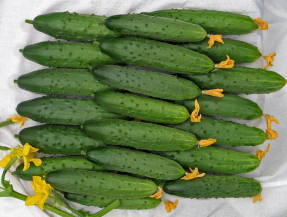
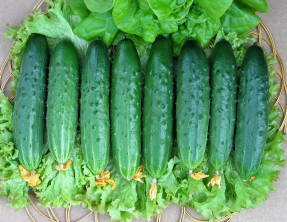
F1 Northern Lights
F1 Relay
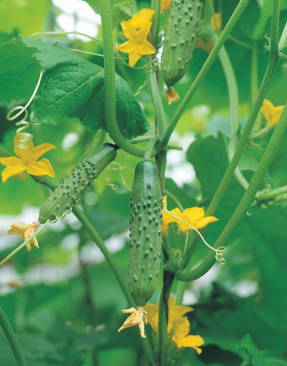
F1 Gladiator
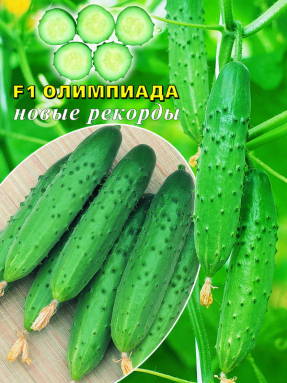
F1 Olympics
Winter cucumbers are bee-pollinated and parthenocarpic, tuberculate and smooth-fruited. The average length of greenery is 15-25 cm; there are also long-fruited forms (with smooth greens) - up to 30-35 cm long. All winter hybrids are late-ripening, characterized by strong vegetative growth, large leaves. The most popular are tuberculate white-thorned hybrids with fruits of a beautiful bright green color 15-22 cm long, large-tuberculate, with excellent taste, for salad purposes. Such cucumbers can be seen on store shelves in the winter. It is necessary to plant 10-15% of pollinating hybrids (F1 Gladiator, F1 Hercules, F1 Ermine) to all bee-pollinated hybrids.
All the main cucumber hybrids cultivated by gardeners and farmers in the summer are included in group of spring-summer cucumber. Such hybrids are the most precocious, have complex resistance to diseases. Among them there are both parthenocarpic and bee-pollinated forms; the length of the greens varies from 6-10 cm (gherkins) to 20 cm. This also includes beam hybrids.
Parthenocarpic and bee pollinated varieties
For protected ground (greenhouses), parthenocarpic forms are best suited, since the formation of the crop does not depend on pollinating insects, which pollinate plants in greenhouses worse. But parthenocarpy (the formation of fruits without pollination) is a sign that depends on growing conditions, any stresses in plants (temperature changes, drought, excessive humidity) reduce its manifestation.
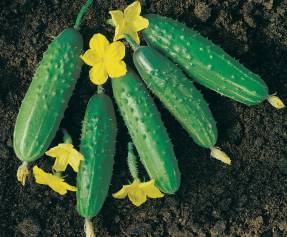
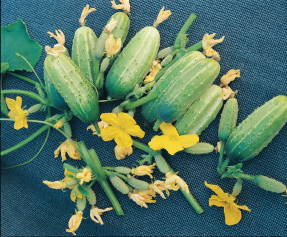
F1 True Friends
Under temporary film shelters and in open ground, both parthenocarpic and partially parthenocarpic and bee-pollinated hybrids can be successfully cultivated. Among bee-pollinated cucumbers, the most popular varieties with a female type of flowering (F1 Farmer, F1 Lord, F1 True friends, F1 ABC, F1 Acorn, F1 Captain, F1 Compass, F1 Teremok, etc.), they are more productive.
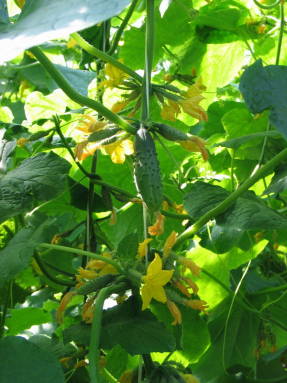
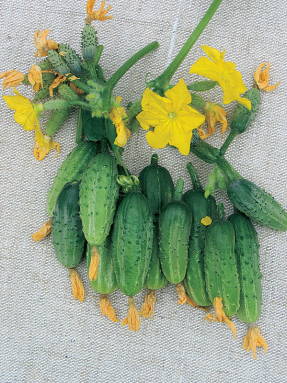
F1 Teremok
But for high-quality pollination, it is necessary to sow varieties that form a large number of male flowers (barren flowers). Breeding firms put colored pollinator seeds into bags of the main bee-pollinated hybrids. On such bags there is a special symbol - a yellow seed in a pink square and the text "colored seeds - pollinator".
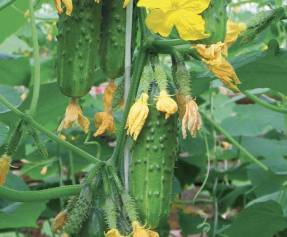
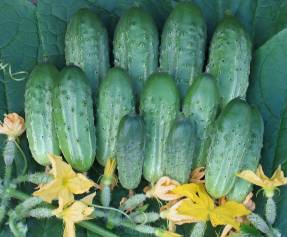
F1 Captain
Cold-resistant varieties
Not all cucumbers, due to their biological characteristics, can tolerate the Spartan conditions of the garden. In open beds, cold-resistant varieties and hybrids are grown, adapted to the drying effect of wind and low air humidity. In addition, Zelentsy should not lose commercial qualities in case of pollination.
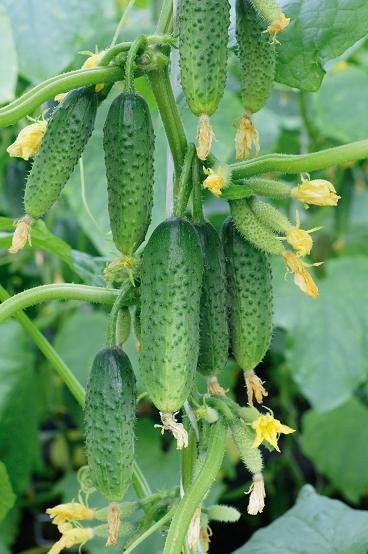
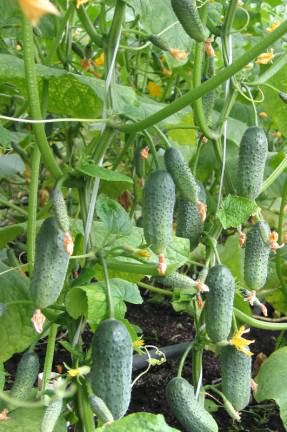
F1 Burevestnik
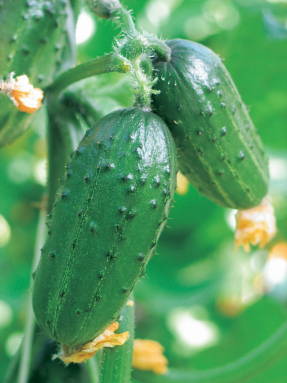
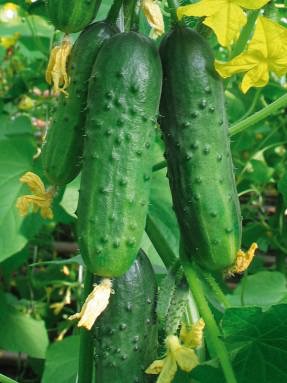
F1 Be healthy F1 Green wave
F1 Anyuta, F1 Be healthy, F1 Petrel, F1 Green wave, F1 Buyan, F1 Peanut, F1 Boy with a finger, F1 Maryina Grove, F1 Dragonfly, F1 Ant, F1 Matryoshka, F1 Grasshopper, F1 Trump Card, F1 Junior Lieutenant, F1 Three tankers, F1 Hit of the Season, F1 Kozyrnaya Karta, F1 Okhotny Ryad, F1 First Class, F1 Cheetah, F1 Balalaika and parthenocarpic F1 Saltan fully meet these requirements.
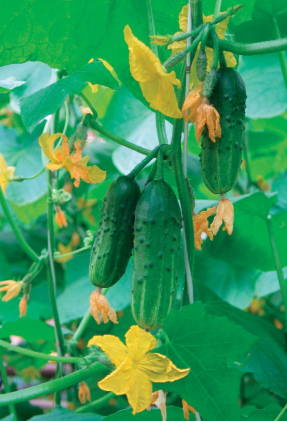
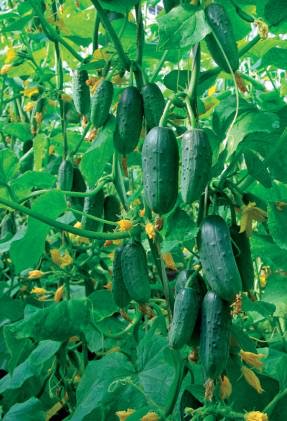
F1 Ant
F1 Okhotny Ryad
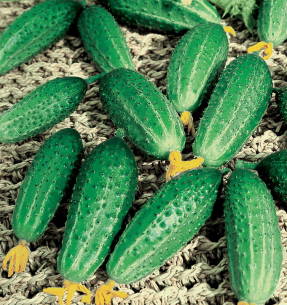
Shade-tolerant varieties
Cucumbers vary considerably in shade tolerance. In summer, you should grow cucumbers of the summer-spring ecotype, which includes most varieties for amateur gardeners. Winter cucumbers, despite their shade tolerance, are not advisable to plant in summer: they are late in terms of ripening, and are more likely to be affected by summer diseases (primarily downy mildew). Light-loving hybrids include all hybrids with a beam arrangement of ovaries at the nodes. In penumbra conditions, it is better to plant shade-tolerant hybrids (F1 Arina, F1 Moscow Evenings, F1 Danila, F1 Mastak, F1 Firm Secret).
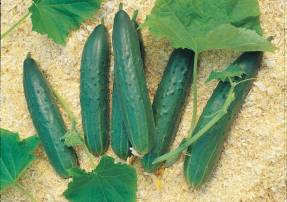
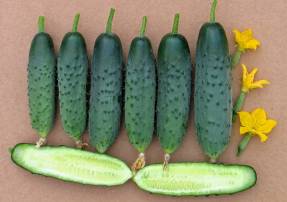
F1 Company secret
Some bunch gherkins also have shade tolerance (F1 Maryina Grove, F1 Chistye Prudy, F1 Hit of the Season, F1 Green Wave).
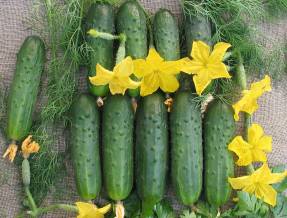
F1 Maryina grove
F1 Chistye Prudy
Early maturing varieties and varieties with a long fruiting period
Cucumber has significant varietal differences in the duration of fruiting. If you want to get a high yield in a short period, grow early sprinter hybrids (F1 Regina-Plus, F1 Amur, F1 Bouquet, F1 Alphabet), which give most of the crop in the first month of fruiting.
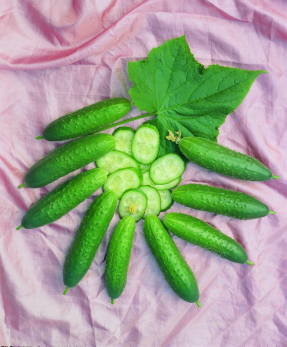
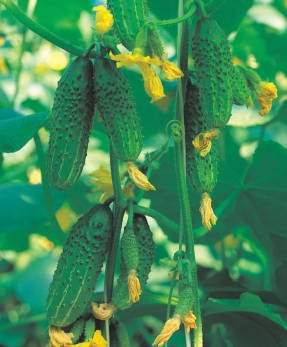
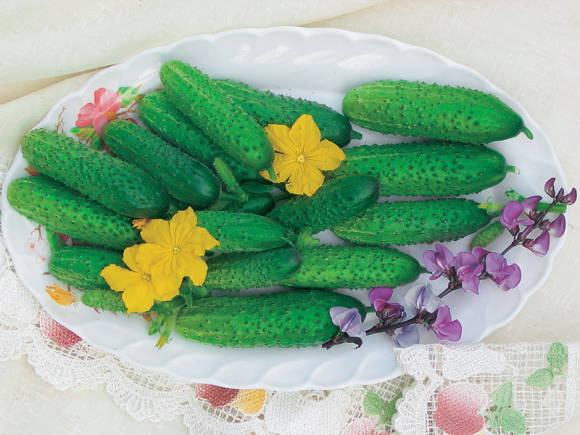
F1 Alphabet
In order to collect a large number of greens in late summer and early autumn, cold-resistant cucumbers with a long fruiting period are planted (F1 Virenta, F1 Saltan, F1 Anyuta, F1 Farmer, F1 Lord, F1 Boy with a finger, F1 Maryina grove).
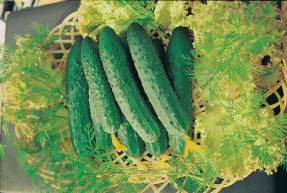
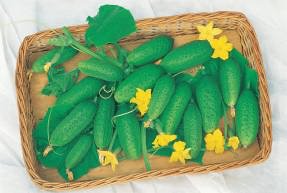
F1 Virenta
F1 Boy with a finger
According to the ripening time, cucumbers are divided into three groups: early-ripening - the period from germination to fruiting is less than 45 days, mid-ripening - from 45 to 50 days, late-ripening - more than 50 days. Plants begin to bear fruit at the time indicated on the seed bag if they were in favorable conditions. Any cucumbers, even the most cold-resistant ones, are significantly delayed in development at low temperatures, which delays the onset of fruiting. Therefore, one should not rush to sow or plant seedlings, spend them at the optimal time (for central Russia in unheated greenhouses - from May 15-20, in open ground - from June 1-5).
Pickling and salad varieties
Varieties of cucumber are distinguished by purpose. There are salad, canning, pickling and universal cucumbers. Salting qualities depend on the density of the skin and the content of pectins and sugars.
Black-thorn varieties are traditionally considered pickling. But pickling qualities do not depend on the color of the pubescence, but on the density of the skin and the content of pectins and sugars in the fruits. Many modern varieties and hybrids have high pickling qualities F1 True Friends, F1 Saltan, F1 Anyuta, F1 Farmer, F1 Lord, F1 Chistye Prudy, F1 Green Wave, F1 First Class, F1 Acorn, F1 Dragonfly, F1 Ant, F1 Grasshopper, F1 Matryoshka, F1 Trump Card, F1 Alphabet, F1 Bouquet, etc.
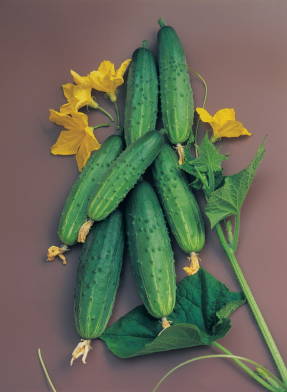
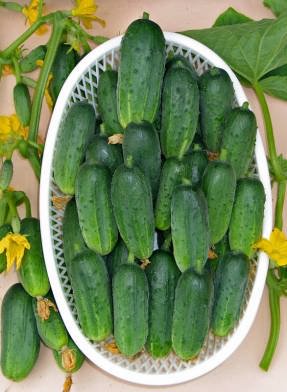
F1 First class
Salad cucumbers have smooth or tuberculate fruits of medium size. Zelentsy has no bitterness, they have crispy sweetish flesh and are consumed fresh (F1 Zozulya, F1 Bazaar, F1 Bukhara, F1 Tamerlane, F1 Kochubey, F1 Martha, F1 Makar, etc.).
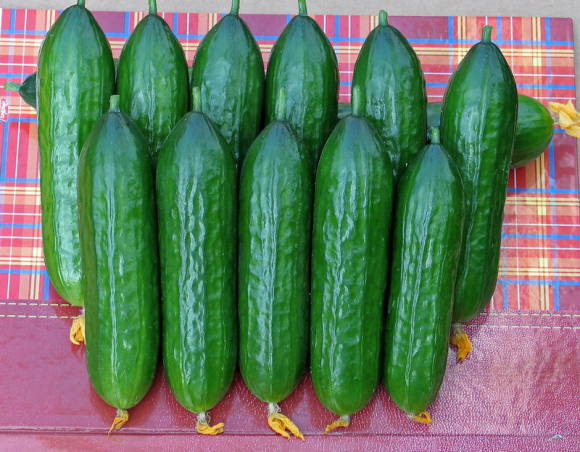 F1 Bukhara
F1 Bukhara 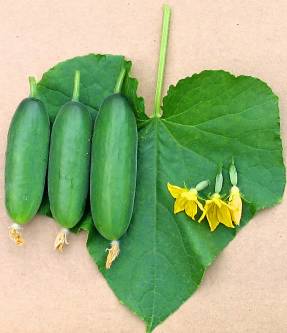
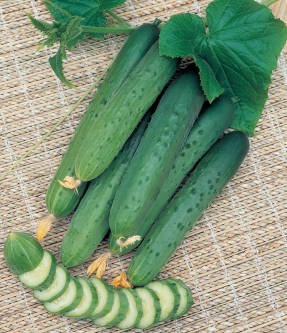
Beam varieties
Cucumbers with a bundle arrangement of ovaries in knots are very popular with gardeners. Their main advantages: an abundance of ovaries and greens, gherkins, excellent pickling qualities, high yields. In the nodes of beam hybrids, from three to eight or more ovaries are formed simultaneously, and up to five hundred can grow on one plant per season! Zelentsov.
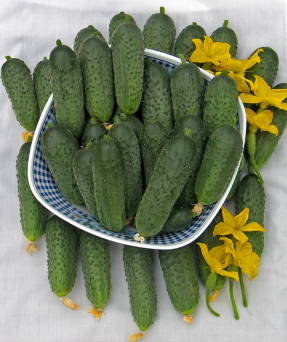
F1 Grasshopper
F1 Dragonfly
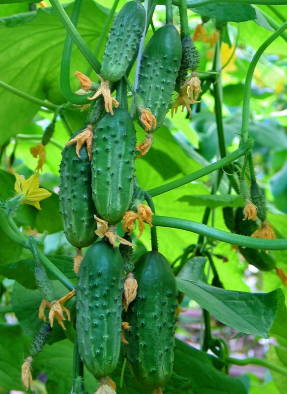
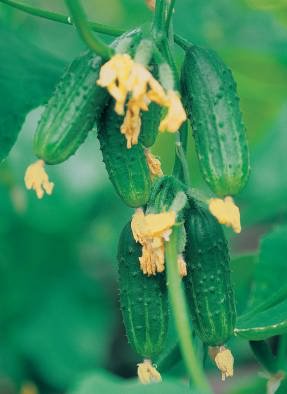
F1 Matryoshka
Beam hybrids can be parthenocarpic (F1 Maryina Grove, F1 Matryoshka, F1 Grasshopper, F1 Dragonfly, F1 Green Wave, F1 Kozyrnaya Karta, F1 Buyan, F1 Hit of the Season, F1 Balalaika, etc.) and bee pollinated (F1 True friends, F1 Teremok, F1 Captain, F1 Acorn, F1 Compass, F1 ABC, etc.).
Varieties with different types of branching
Under good branching understand the growth of lateral shoots from almost every node of the main stem; lateral shoots are long, requiring pinching in greenhouses. Many modern hybrids with good branching are characterized by a valuable feature - SELF-REGULATION OF BRANCHING, when a high crop load on the main stem does not allow lateral shoots to form quickly (F1 Maryina Roshcha, F1 Chistye Prudy, F1 Matryoshka, F1 Junior Lieutenant, F1 Buyan, F1 Burevestnik, F1 Boy with a finger, F1 Hit of the Season, F1 Green Wave, F1 Dragonfly, etc.). In the future, when most of the crop is harvested from the main stem, the side shoots will begin to grow faster. Thus, in the presence of self-regulation of branching, much less time is spent on pinching side shoots. This is especially important if your stay is garden plot comes down to weekends - such plants do not have time to overgrow too much during the working week.
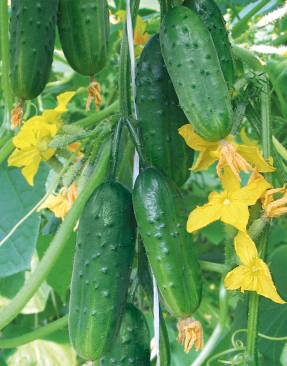
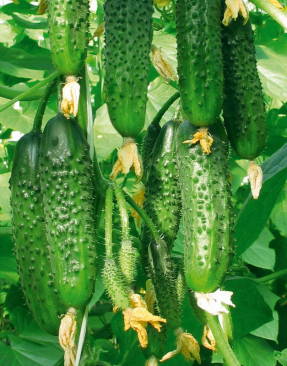
F1 Second Lieutenant
F1 Hit of the season
Good branching is the key to long-term active fruiting (the more branches the cucumber, the longer the potential return period of the crop). The sign of good branching is important for cucumbers grown in the open field and under temporary film shelters, as well as in greenhouses for obtaining a crop over an extended period. special attention cucumbers with good branching deserve southern regions countries, as under conditions of overheating, weakly branching cucumbers quickly finish fruiting.
In hybrids with moderate or limited there can be many branching of lateral shoots, but they are not long, with shortened internodes. With this trait, a group of unique hybrids (F1 Ant, F1 Grasshopper, F1 Kozyrnaya Karta, F1 Mazay, etc.) was created, combining limited shoot growth with a rather long fruiting period. Other hybrids (F1 Cheetah) may have fewer side shoots per plant, although they grow well and grow longer. Such plants are much easier to form. Hybrids with limited branching are equally successfully cultivated both in protected and open ground.
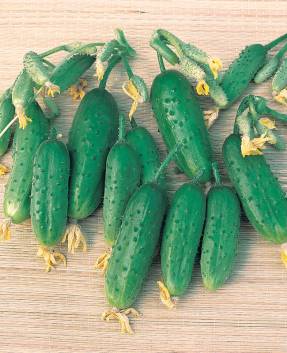
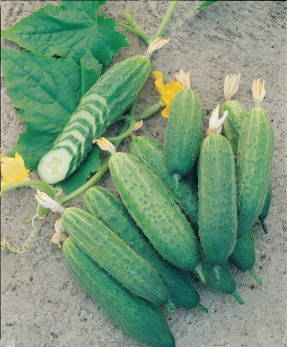
F1 Trump Card
Into the cucumber group weak branching includes early-ripening sprinter hybrids that give most of the crop in the 1st month of fruiting: F1 Alphabet, F1 Amur, F1 Regina-plus, F1 Bouquet, F1 Balalaika, etc. Side shoots are practically absent - i.e. they are very short (up to 10-15 cm) “bouquet branches” - with close internodes, often without leaves, which stop their growth themselves. Such bouquet branches with pouring greens look like bunches of fruits.
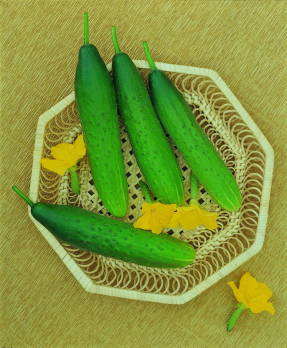
F1 Regina-plus
F1 Balalaika
After the first - the main wave of fruiting, the second wave comes - from the bouquet branches. Hybrids with very little branching are ideal for when you need to get the maximum yield in a short time - for example, during a short summer vacation. An increased early yield here is also achieved due to a denser planting: instead of 2.5-3 plants/m2 to 5-6 plants/m2. In hybrids of this group, the main lash is long, providing a much higher yield compared to bush forms.
For northern regions With short summer, late spring and early frosts, when grown in open ground and unheated greenhouses, it is desirable to select early-ripening hybrids with moderate or weak branching. Hybrids with strong branching simply do not have time to give their entire crop.
IN central Russia cucumbers are suitable for open ground and film, both with limited and medium and good branching. Well-branching hybrids will give a higher yield in late summer - early autumn. In heated greenhouses, where the fruiting period lasts longer, well-branching hybrids are preferred.
On the site it is better to plant several varieties, different in purpose and terms of cultivation. This will increase the period of consumption of cucumbers and the chances of getting a good harvest under different weather conditions.
